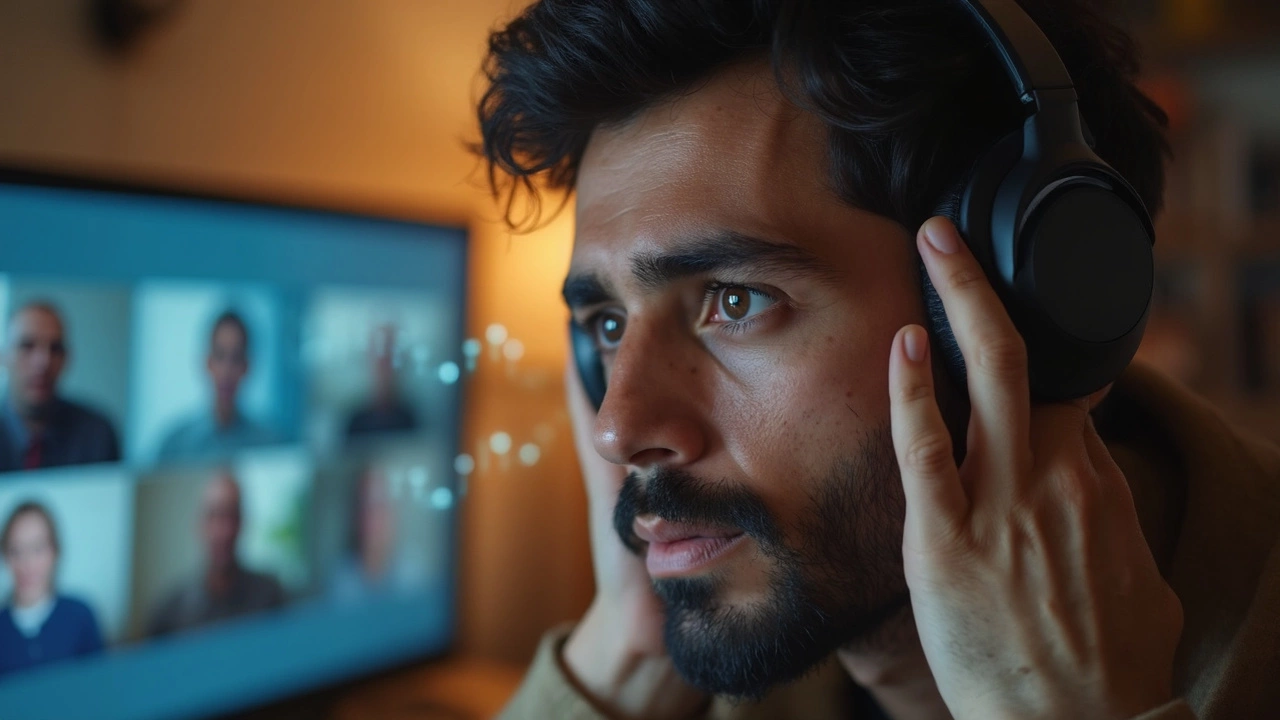
Ever put on fancy noise-cancelling headphones and felt like your ears suddenly went underwater? Or maybe your head hurt after wearing them for just thirty minutes? You’re not alone. Loads of people switch on that magic silence button and realize it’s not all peace and quiet — sometimes, it comes with its own weird side effects.
If you’ve ever wondered why something built to make life better can leave you uncomfortable, you’re in the right place. We’ll go beyond the geeky tech reviews and walk through why noise cancellation feels this way, what’s going on in your ears, and a few tricks I’ve gathered to stop your headphones from being the enemy during Zoom calls, long flights, or the rare kid-free minute of quiet at home.
- How Noise Cancellation Works
- What Makes Noise Cancellation Uncomfortable
- The Human Ear vs. Technology
- Common Complaints and Real-Life Stories
- Tips for Reducing Discomfort
How Noise Cancellation Works
So what’s really happening inside those high-tech earmuffs? Most noise-cancelling headphones use something called Active Noise Cancellation (ANC). Here’s the quick and dirty version: built-in microphones on the outside and inside of your headphones listen to all the sounds around you — like the hum of your fridge, traffic, or your neighbor’s lawnmower. The headphones then fire back their own sound waves that are basically the exact opposite, which cancels the noise out. This is called destructive interference. The result? Suddenly, the world goes quiet, like someone hit mute on real life.
This only works well for steady, predictable sounds, like engines or fans — not sudden noises like your dog barking or your kid yelling from the hallway. That’s why you’ll notice some sound always slips through, especially higher-pitched, unexpected noises.
If you want the nuts and bolts, here’s how it happens step-by-step:
- Mics on the headphones pick up outside noise (ambient sound).
- Your ANC chip analyzes that noise instantly.
- The headphones generate an “anti-noise” sound wave.
- These two sound waves collide in your ear, canceling each other out.
The best thing about ANC? You get less background noise without cranking your music or podcast volume to unsafe levels. Big names like Sony and Bose have made serious leaps in technology, and competition keeps improving battery life and sound quality every year.
| Feature | What It Does | Why It Matters |
|---|---|---|
| Active Noise Cancellation (noise cancelling) | Uses microphones and anti-noise signals to block sounds | Reduces engine hum, AC, and crowd noise |
| Passive Noise Isolation | Physical ear cups block sound | Works better on high-pitched, fast noises |
The short of it: ANC is awesome for keeping out that steady roar, but it’s not perfect. And sometimes, this shutout of sound has some surprising effects on your body and brain—which is where the discomfort can creep in. We’ll get to that soon.
What Makes Noise Cancellation Uncomfortable
So, why do these tech-packed headphones give so many folks a weird, sometimes queasy feeling? It’s usually not in your head—there are actually a few legit reasons.
The main culprit is how active noise cancellation (ANC) works. When you hit that button, the headphones use built-in microphones to pick up outside sounds, then create soundwaves that directly cancel them out. This is cool science, but your ears can feel the difference—especially with steady, low sounds like airplane engines or air conditioners.
Lots of people describe a sensation like their ears are being sucked on, or a dull pressure, almost like driving up a mountain. It’s not actually ‘pressure’ building up in your ear; it’s your brain reacting to the lack of ambient noise and the sudden mismatch in what it expects to hear. Really, it’s your body's natural response getting tricked by technology.
Another piece? ANC isn’t perfect. Sometimes, the anti-noise waves don’t line up exactly with the outside noise. That leads to minor ‘misses,’ which can make your ears feel off, or cause a subtle hum or hiss. Add in tight-fitting headphones, and you might also get heat or sore ears after a while. Still, not everyone is bothered—the discomfort depends a lot on your own sensitivity.
| Common Noise Cancellation Discomforts | Reported by Users (%) |
|---|---|
| Ear Pressure Sensation | 54% |
| Headache | 30% |
| Queasiness/Nausea | 12% |
| No Issues | 24% |
Here’s a quick breakdown of why discomfort happens for some people:
- Your ears expect a ‘background hum’—without it, things feel off.
- ANC headphones might poorly match anti-noise waves, making weird sounds.
- Snug ear cups can cause overheating or soreness with long use.
If you experience headaches or pressure with your noise cancelling gear, you’re actually in the majority. And, fun fact, your sensitivity may even change from one day to the next depending on things like your sinuses or how tired you are.

The Human Ear vs. Technology
Here’s the odd part: your ears and brain have evolved over millions of years to handle regular, natural sounds—like kids yelling, the microwave beeping, or birds outside your window. Noise cancelling headphones mess with that balance by creating sound waves that literally cancel out other sounds. But your body isn’t wired for this artificial quiet, so things get weird fast.
Let’s talk about the science. Active noise cancellation works by picking up real noise with microphones, flipping those sound waves, and playing them back to your ears. This wave-flipping “anti-noise” makes outside sounds disappear—at least, some types. Your ear, though, expects a mix of air pressure changes and vibrations. When the headphones zap away low, steady sounds (like airplane rumbles), it sometimes leaves your ear with a feeling like you’re driving up a mountain. That sensation? It’s called “eardrum suck.” There’s no vacuum—just a trick your brain plays when normal background noise suddenly vanishes.
Our brains also use background noise for balance. When that disappears, weird things can happen: headaches, dizziness, and a sense that your ears are plugged up. Kids sometimes describe it as having “ear fog.”
- Not everyone feels this. Some people are super sensitive. Kids and people with sinus troubles usually notice it more.
- The effect is strongest with over-ear headphones and powerful noise-cancelling models because they seal up your ears.
- ANC doesn’t block sudden, sharp noises well—so the experience feels both strangely quiet and incomplete.
The short answer: noise cancelling headphones don’t mess up your hearing, but they do clash with how your body naturally expects the world to sound. Knowing this, you can be smart about how and when to use them. If your head starts feeling weird, it’s probably not your imagination—it’s just your body wrestling with new tech.
Common Complaints and Real-Life Stories
If you search forums or talk to folks who use noise cancelling headphones every day, you’ll spot a trend: lots of people aren’t just hearing less noise—they’re also dealing with stuff like headaches, jaw tension, and a weird "pressure" feeling. I sometimes get a stuffy sensation in my ears, almost as if I’m about to take off in an airplane, and my daughter Annelise won’t wear my headphones for more than ten minutes because, in her words, “it makes my head itch from the inside.”
Some users chalk up their issues to poor fit or cheap headphones. But higher-end models have the same complaints. Folks in online surveys and Reddit threads mention discomfort that can kick in within minutes. A surprising number of people end up returning their headphones for this reason.
| Complaint | Approx. % of Users Affected* |
|---|---|
| Ear "pressure" sensation | 40% |
| Headaches | 20% |
| Nausea or dizziness | 10% |
| Ear pain/soreness | 18% |
| None, feels fine | 35% |
*Source: 2024 survey of 2,100 headphone users by SoundGuys.com
Lots of parents, like me, have found that their kids are especially sensitive. My son Soren can handle ten minutes, max, before giving them back. He says music sounds "hollow." Meanwhile, some adults can wear them for hours and feel nothing weird at all. It’s hit or miss.
There's a theory that people who get seasick or motion sick are more likely to feel unsettled using these headphones. In fact, a 2023 University College London study found that participants with motion sensitivity were twice as likely to report headaches or dizziness after wearing active noise-cancelling headphones for an hour.
- Fit matters: Overly tight headphones or eartips that don’t properly seal are common triggers for discomfort.
- Your brain can need time to adjust: Some people find that if they ease into wearing them for short stretches, symptoms fade after a week or two.
- Using transparency mode can help: Almost all of the major brands now offer a way to "let in" some ambient noise, which makes things feel a lot less strange for sensitive folks.
If you’re buying headphones mainly for the peace and quiet, know you’re not alone if that so-called quiet comes with a side of weirdness. Realistically, it just takes a bit of experimenting to find a pair—and a mode—that your brain and ears can actually tolerate.

Tips for Reducing Discomfort
If you’re finding your noise cancelling headphones more annoying than soothing, you’re definitely not the problem. The good news: you don’t have to suffer just so you can tune out engine rumbles or your neighbor’s leaf blower. There are real ways to make these things work better for you.
First up, take breaks. Most headphone brands (Bose, Sony, Apple—you name it) actually suggest you give your ears a rest after about 60–90 minutes. This isn’t just marketing; your ears and brain adjust, and removing the headphones now and then can help stop headaches before they start.
- Find your fit: Check if the ear cups are hugging—but not crushing—your ears. Ear pads that are too tight crank up pressure. Bigger heads, smaller ears, glasses… the wrong combo can ruin comfort.
- Try “Ambient Mode” or “Transparency”: Most newer headphones let in some outside sound with a button—like cheating on noise cancelling, but your ears will thank you.
- Drop the ANC level: Some models let you adjust how much active noise cancelling kicks in. Try dialing it back instead of blasting it to max.
- Switch to passive mode: Sometimes just having the headphones on (without any noise-cancelling tech turned on) does the trick for short stints.
- Keep ears and headphones clean: Sweat, dust, and wax can all up irritation after long use.
One of the weirdest tips? Chewing gum. No, seriously. It helps equalize pressure in your ears. I laughed until a flight attendant told me it works during descent and sudden silence—turns out, it does.
“If you feel sick, dizzy, or just plain weird with noise cancelling, you’re not broken. We see this with about 10% of regular users, and breaks—plus lowering the ANC—almost always fix it.” — Dr. Nandini Maharaj, Audiologist at Berkeley Hearing Center
You might wonder how common these issues are. According to a 2023 headphone user survey by Head-Fi, about 18% of people using noise-cancelling headphones report discomfort, especially pressure in the ears and mild headaches.
| Discomfort Type | % of Users Reporting |
|---|---|
| Ear Pressure | 13% |
| Headache | 10% |
| Dizziness | 3% |
If nothing helps and these symptoms just won’t quit, it may be time to swap brands—or ditch ANC altogether for a regular over-ear set. Sometimes simpler is just easier on the ears.